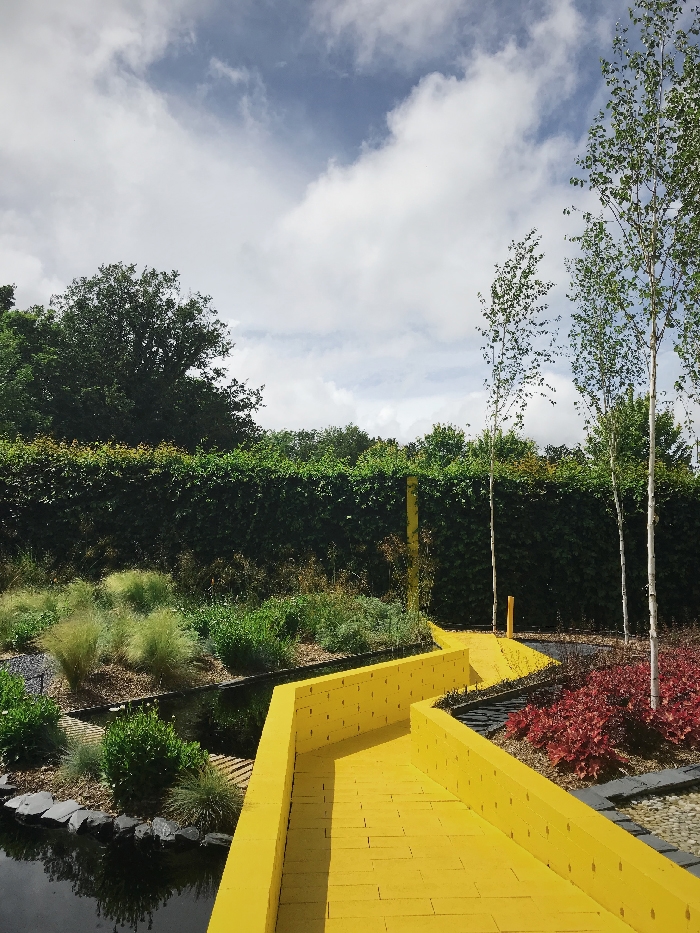
FAYETTEVILLE, Ark. – A team of University of Arkansas faculty, staff and students designed a garden that was selected for the 2019 International Garden Festival at Chaumont-sur-Loire, a historic castle in France's Loire River Valley.
Windy Gay, formerly an instructor in interior design at the Fay Jones School of Architecture and Design, led the design team, which also included Justin Tucker, fabrication specialist in the school; Beau Burris, an honors landscape architecture student; and Dallas Myers, then a fifth-year landscape architecture student. In addition to being selected for the festival, the design team also won the Prize for Design: Innovation. Tucker and Myers are both university alumni, receiving a Bachelor of Architecture in 2016 and a Bachelor of Landscape Architecture in 2019, respectively.
Their garden will be on display at the festival through Nov. 3, along with more than 25 other works from the Netherlands, United States, South Korea, Vietnam, Singapore, Italy, England, Belgium, Japan, South Korea and France, all centered on the theme "Gardens of Paradise."
The team's design, called "Inhabiting the Wall," was selected from hundreds of design proposals for the International Garden Festival, which is in its 28th year. Over six-plus months, the festival is expected to attract more than 400,000 visitors from around the world.
Their garden explores paradise as a place of awareness, integration and learning that exists inside everyone, as opposed to a separated space of comfort. It occupies the wall between the known and the unknown.
"To come in and experience something as paradise, you also have to walk through these places of discomfort," Tucker said.
Tucker said that Gay came up with the idea for the garden early on, and then she discussed it with him to help refine the plan and determine what was possible. Later on, Burris helped Gay by creating drawings for the proposal. Myers also worked on the drawings and detailing, and he helped Tucker with cost estimates and construction methods.
"I completed a set of drawings that communicated the vision for the garden, collaborating with Dallas Meyers and Justin Tucker to ensure that what I drew was actually buildable," Burris said.
After their garden was selected in December, the four of them made up the group that installed the garden at the site, along with Scott Biehle, teaching assistant professor in landscape architecture, and Max Frank, an honors landscape architecture student who came during the second week.
For the students, being part of the process gave them a chance to experience and see the full design process.
"For me, it set up a lot of things I'm going to learn in the next few years," Frank said. "That will be really cool to have some hands-on experiences to be able to reference later on."
Burris said he was able to put what he's learned in the classroom to use.
"The skills I've developed as a landscape architect were absolutely essential to my role in the team," Burris said. "Understanding color and texture was vital to bringing such a small space to life."
The garden includes a yellow brick path that cuts a jagged schism through the middle of the garden, which is divided into further sections that contrast the known with the unknown. On one side of the path, there is the Garden of the Optimist, with a reflecting pool, and the Garden of Reveries, with undulating meadow mounds. On the other side, the Garden of the Anxious Unknown has dark gray slate and extruded strips of planting beds, and the Garden of the Curious Mind includes a birch forest arising from a dark forest floor.
"You walk down this yellow path, and you just get this sense of these two very different worlds going on either side of you, but the whole thing is still really harmonious," Frank said.
The design team spent 10 days in March installing the roughly 2,000-square-foot garden at Chaumont-sur-Loire. Tucker said that when they arrived, they pulled back a tarp to find an empty site of roughly graded dirt surrounded by a hedge.
"That was a very overwhelming moment because we started laying this thing out and realizing what the scale was really going to be standing there," he said.
They immediately got to work. Tucker said they started with the brick path because every other aspect of the garden relied on it. They hired an excavator, because the path dips below ground level. Then they worked on the other parts, building the necessary edges and framework, bringing in the water for the reflecting pool, and then filling in the rest of the site.
However, one part of the design didn't pan out. Tucker said the yellow path was supposed to be covered with little flecks of gold that would have toned down the brightness. Unfortunately, the bag containing the glitter was lost in the airport.
"Windy was happy with it, but we all knew it was a little bright," Tucker said.
Most of their supplies were ordered ahead of time so they were ready to go when the build team arrived. They had a few issues getting all the supplies they needed because a few items aren't as readily available in France as in the United States, so they had to substitute.
Because the festival is an annual event, gardeners at Chaumont-sur-Loire also save the healthy plants and good materials for use by participants the following year. Tucker said their team used plants and some gray slate from previous designs, which really helped them keep the project within a tight budget.
Find more images and details about this garden design on the school's Form Plus Function blog.
Topics
Contacts
Shawnya Lee Meyers, digital media specialist
Fay Jones School of Architecture and Design
479-575-4744, slmeyers@uark.edu
Michelle Parks, director of communications
Fay Jones School of Architecture and Design
479-575-4704, mparks17@uark.edu